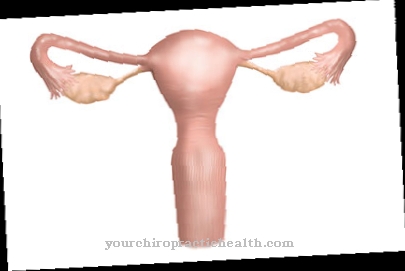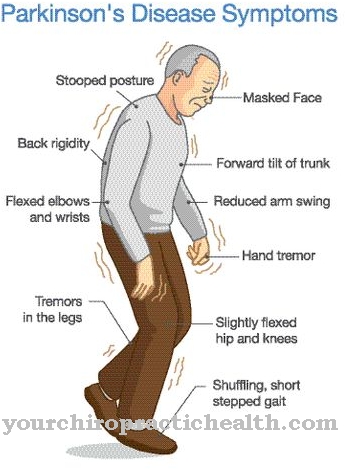The Cornelia de Lange Syndrome (CdL syndrome) is a genetic dysmorphic syndrome. In connection with this, there are severe to exceptionally slight cognitive disabilities. The severity and prognosis of this disease are very variable.
What is Cornelia de Lange Syndrome?

© Kadmy - stock.adobe.com
If it is severe, Cornelia de Lange syndrome is very easy to diagnose based on the multitude of physical dysmorphisms. Along with the physical changes, there is always a mental handicap. The intellectual disabilities are often severe to moderate. In exceptional cases they are also lighter.
Cornelia de Lange syndrome is a genetic disease, the exact cause of which is still not entirely clear. The disease was described in 1933 by the Dutch pediatrician Cornelia de Lange in two children. The syndrome is also by the name Brachmann de Lange Syndrome known. Outwardly, the disease seems to be very variable. The internal organs can also be affected.
Patients particularly often suffer from reflux disease, which can be very painful. Cornelia de Lange syndrome occurs in around 10,000 people. Life expectancy is limited, for example, due to complications from aspiration pneumonia after vomiting.
causes
The cause of the syndrome is a genetic change. However, there is no uniform mutation. In about 50 percent of cases, mutations are found on the NIPBL gene, which is located in the p13 region on chromosome 5. The gene produces the protein delangin (von de Lange), the importance of which is not yet recognized. The different manifestations of the disease may be related to the fact that it is caused by different mutations in the NIPBL gene.
In other cases, chromosome changes are noticeable, which, however, as in metabolic disorders, are likely to be side effects. Since variable manifestations of the disease also occur within a family, it is assumed that other genes are also involved in the development of the disease. Studies have found that an affected person's siblings have a 2 to 5 percent chance of having this syndrome as well.
With an autosomal recessive inheritance, the risk is 25 percent. In some cases, however, there are some arguments in favor of an autosomal dominant inheritance. In rare, rather mild cases of the CdL syndrome, according to recent findings, mutations in the SMC1A gene and the SMC3 gene can be traced back.
Symptoms, ailments & signs
The main symptom of Cornelia de Lange syndrome is a general developmental delay, which is observed long before birth during ultrasound examinations during pregnancy. The child is underweight and too small after birth. Feeding problems caused by gastro-oesophageal reflux arise right at the beginning. The reflux results from insufficient occlusion between the esophagus and stomach.
The result is frequent vomiting with a risk of aspiration. The frequently observed restlessness and the auto-aggressive behavior are probably due to the symptoms of reflux. Outwardly, there are fairly typical dysmorphisms such as bushy converging eyebrows, a large interpupillary distance, long eyelashes, the eyelid axes sloping downwards, a large distance between nose and mouth, a wide and flat nose with forward-facing openings, deep-set ears, a small lower jaw and much more.
There are also abnormalities in the hands and feet. Sometimes congenital heart defects and epilepsy occur. The genitals are also poorly developed. Visual disturbances and hearing loss sometimes occur. Especially in the first years of life, the behavior is often auto-aggressive with autistic features. An intellectual disability is always present from severe to exceptionally mild forms.
diagnosis
The diagnosis of Cornelia de Lange syndrome is based on its characteristic appearance. However, so far there are no cytogenetic or molecular genetic findings. Imaging procedures such as MRI can provide information about structural changes in the brain.
Furthermore, development diagnostics should be carried out with a check of the sensory functions. An X-ray examination is necessary if gastro-oesophageal reflux is suspected in order to adequately treat it. Other syndromes such as Coffin-Siris syndrome, Peters-Plus syndrome or oto-palato-digital syndrome should be differentiated from the differential diagnosis.
Complications
Due to the complexity of Cornelia de Lange syndrome, complications can arise at any time. The most obvious complication occurs when the ingestion of food is made difficult due to the lack of gastric obstruction. If this complication leads to gastro-oesophageal reflux, the affected child can inhale parts of the food that has already been digested.
Frequent vomiting can also lead to aspiration-related pneumonia or inhalation-related pneumonia. This complication can endanger the life of those affected. Aspiration pneumonia always occurs when foreign substances such as gastric juice, seawater or other foreign substances are inhaled.
The pneumonia caused by this also causes local inflammatory reactions and breathing disorders in Cornelia de Lange syndrome. This complaint, in turn, favors a grafted second or suprain infection with other bacterial pathogens. The prognosis is particularly poor if gastric juice has been inhaled.
Aspiration symptoms may take a long time to manifest. Bronchospasm or increased secretion can be important signs of aspiration-related pneumonia. Breathing is difficult and the patient may turn blue.
Without an immediate clinic visit, patients with Cornelia de Lange Syndrome cannot receive professional help. Those affected must immediately undergo bronchoscopy and antibiotic therapy if the X-ray has confirmed the suspicion of aspiration-related pneumonia. The individual case decides whether or not oxygen administration is necessary.
When should you go to the doctor?
If feeding problems arise after the sick child is born, this must be treated immediately. Most of the time, Cornelia de Lange Syndrome was diagnosed at this point. Parents should consult their pediatrician regularly and call the emergency doctor in the event of complications. Signs of a heart defect or epilepsy should be clarified immediately so that countermeasures can be taken immediately. In the event of an epileptic attack or even a heart attack, the emergency services must be alerted immediately.
If you have visual disturbances or hearing loss, it is best to consult the appropriate specialist. In the case of intellectual disabilities, it is advisable to seek therapeutic support and to call in nurses at an early stage. In later life, the affected child may also need psychological support, always depending on the severity of the Cornelia de Lange syndrome and its symptoms.
Basically, the person concerned must receive medical and therapeutic care into adulthood and often beyond. The family doctor or pediatrician will support the parents in finding the right contact person for the individual complaints.
Doctors & therapists in your area
Treatment & Therapy
A causal treatment of Cornelia de Lange syndrome is not possible. Early intervention as well as psychological and educational measures should start as early as possible. Sometimes behavior therapy measures are also necessary in order to weaken the autoaggressive reactions. Targeted funding leads to continuous development progress.
The treatment of gastro-oesophageal reflux is particularly important. He is responsible for the limited life expectancy of the person affected, as vomiting can lead to aspiration pneumonia. In addition, he can often be responsible for the child's auto-aggressive behavior. If drug treatment is inadequate, surgical measures may be necessary. If facial anomalies and limb malformations lead to functional impairments, surgical correction is also indicated here.
Furthermore, visual disturbances and hearing impairments should also be treated. From adolescence, the hyperactive behavior slowly decreases on its own. The short stature as well as severe and moderate forms of mental disability remain. In order to increase the life expectancy, a constant health monitoring of the patient is necessary.
Outlook & forecast
A general prognosis cannot be given for Cornelia de Lange syndrome. This is very much dependent on the exact severity of the syndrome. However, there cannot be a complete cure for this disease, as it is a hereditary disease that cannot be treated causally.
For this reason, treatment is only based on symptoms. Special and targeted support can alleviate the symptoms and ensure normal development of the patient. In most cases, drug treatment is sufficient for other complaints; surgical interventions are only necessary in severe cases.
If Cornelia de Lange syndrome is not treated, tumors can develop, which reduce the patient's life expectancy. Furthermore, the hearing and visual disturbances also have a very negative effect on the quality of life of the person concerned and can continue to deteriorate without treatment.
Treatment cannot completely resolve these disorders, but it can stop them from getting worse. However, those affected are still dependent on regular examinations in order to avoid further complications. It cannot be generally predicted whether the syndrome will lead to a reduced life expectancy in the patient.
prevention
It is not possible to prevent Cornelia de Lange syndrome. It is a genetic disease that usually occurs sporadically. However, with a sporadic occurrence, the siblings of those affected have a 2 to 5 percent chance of being born with this syndrome. In the case of an autosomal recessive inheritance, the probability is even 25 percent. For this reason, genetic counseling should be sought in affected families.
Aftercare
The problem with Cornelia de Lange syndrome is that although it already occurs in childhood, it is usually diagnosed much later. Symptomatic treatment is therefore often a long time coming. Drug treatment is difficult.Due to the rarity of Cornelia de Lange syndrome, only a few drugs are currently available that are suitable for the complex symptoms.
It starts with early medical intervention and surgical treatment of the severe defects that are associated with Cornelia de Lange syndrome. After the diagnosis, social medical follow-up is often the most important issue. Aftercare is about making life as bearable as possible for the affected children and adolescents and their heavily stressed families.
The integration of interdisciplinary treatment strategies makes sense for Cornelia de Lange syndrome. Follow-up care also includes offering the patient aids to counteract their cognitive deficits through computer-aided memory training or learning training units.
For aftercare for Cornelia de Lange Syndrome, financial aid can be requested from various providers - if necessary also through associations that provide support with social medical aftercare or with necessary preventive care. Most of the time, the affected children receive a higher level of care.
You can do that yourself
Cornelia de Lange syndrome is associated with a large number of congenital anomalies. The causes of the disease have not yet been conclusively clarified. There are neither conventional medical nor alternative methods that are aimed at treating the disease causally. Those affected and their relatives can help alleviate the symptoms and make everyday life more bearable.
The disease is already noticeable in babies. Slow development, particularly affecting intellectual abilities, often occurs in children. All those affected suffer from mental retardation, but this can vary in severity. It is important for the sick children that they receive optimal support as early as possible. Mental development can be positively influenced by adequate psychological and educational measures. In addition, behavior therapy is often required to moderate the patient's autoaggressive reactions.
Since caring for and living with a mentally and physically disabled child can also be very stressful for the parents and other family members, this group of people should not be afraid to seek psychological help or to join a self-help group.
























.jpg)



